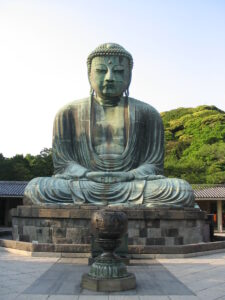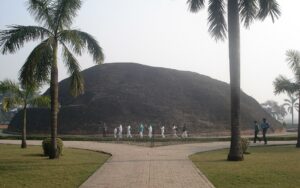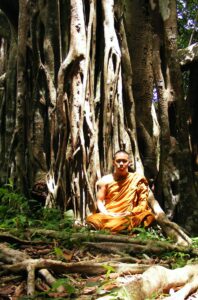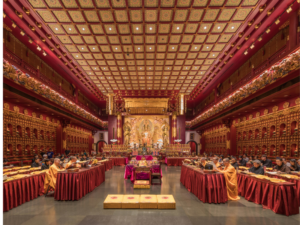 BBC News
BBC NewsBorrowing was £17.4bn last month, the second highest October figure since monthly records began in 1993.

As work burnout increases, Christopher Jackson wonders whether the answer might lie in the ancient world
It was one of my better decisions. I stepped off the mad streets of London into the Fo Guang Shan Temple on Margaret Street, and was immediately struck by the atmosphere of tranquility. A group of Buddhist monks were hovering in the courtyard, and I felt myself suddenly in a world that had nothing to do with the rush of luxury, tourism and professions outside.
Housed in a Grade II-listed building designed by Victorian architect William Butterfield, the temple’s architecture isn’t really historic by London standards: it can’t quite compete with the great receding spaces of Westminster Abbey, or even Westminster Cathedral. But what it can do is transport you straightaway into another tradition altogether.
The temple’s interior is adorned with traditional Buddhist iconography, including a prominent Buddha statue. We all known the sort of statue, but how often do we really pause and think about what it means in a fast-paced world. In short, what can the Buddha do for our careers?
Right Livelihood
When it comes to the life of the Buddha, much of what we know is drawn from early Buddhist texts, such as the Pali Canon, the Sanskrit and Chinese Agamas, and later biographies like the Buddhacarita by Ashvagosa and the Lalitavistara Sutra. While these sources were written down centuries after his death, they often reflect a strong tradition of oral history, which has preserved key events in the lives of famous figures with remarkable consistency.
Siddhartha Gautama was born a prince in what is now Nepal around 2,500 years ago. Like St. Francis of Assisi, he was born into privilege, yet he quickly realised that material wealth and luxury did little to nourish the soul. His father, determined to protect him from life’s hardships, created a world where suffering simply didn’t exist—at least within the palace walls. He was surrounded by music, feasts, and every pleasure money could buy. For a modern equivalent one might need to imagine Brooklyn Beckham, or perhaps Malia and Sasha Obama. But eventually, curiosity took hold, and he ventured beyond his royal sanctuary.

Buddha Daibutsu, Kamakura
What he saw changed everything. Old age, sickness, and death—realities from which he had been carefully shielded—were suddenly unavoidable. And then, in stark contrast to this suffering, he saw a wandering ascetic, a man who had renounced material life in search of wisdom. It was a moment of awakening. Siddhartha realised that his privileged existence was an illusion, and that true understanding could only come from stepping outside of it.
So, he did. Leaving behind his title, his wealth, even his family, he embarked on a journey of spiritual discovery. He sought out renowned teachers, practiced severe asceticism, and at one point, nearly starved himself in the belief that self-denial was the key to enlightenment. But then he had another revelation: neither indulgence nor extreme deprivation held the answer. There had to be another way.
This insight led him to the famous insight of The Middle Way—a path of balance between excess and hardship. And so, under a Bodhi tree in Bodh Gaya, he sat in meditation, vowing not to rise until he had found the truth. After days of deep contemplation, enlightenment came. Siddhartha Gautama had become the Buddha—the Awakened One.
His teachings would go on to shape one of the world’s great spiritual traditions, rooted in wisdom, ethical living, and mental discipline. Among them was the Noble Eightfold Path, a guide to living well. One of its key principles? Right Livelihood (Samma Ajiva)—the idea that the work we do should be ethical, meaningful, and cause no harm.
As Emma Roche, a philosophical life coach, explains, “Right Livelihood is one of the steps in the Noble Eightfold Path, which serves as a guide for ethical living. At its heart, it is about engaging in work that is morally wholesome and does not harm others or the planet. It encourages us to pursue work that benefits society.”
What exactly does this entail? In Thich Nhat Hanh’s beautiful narrative Old Path White Clouds – the best first port of call for anyone who wants to know about the Buddha’s life – the author recounts how the Buddha advised his disciples about work: “For work to be meaningful, it must be done with mindfulness and compassion.” The book eloquently describes how the Buddha taught that our livelihood should not cause harm to other beings and should ideally contribute to alleviating suffering. As Thich Nhat Hanh writes, “The Buddha emphasized that how we earn our living affects not just our own well-being, but the well-being of countless others connected to us.”

The Buddha advised his followers to avoid occupations that cause harm to living beings or that involve dishonesty. Instead, he encouraged work that contributes positively to society and aligns with ethical principles. In the Anguttara Nikaya, the Buddha specifically mentioned avoiding trades in weapons, living beings, meat, intoxicants, and poisons.
This is where we bump up against what we might charitably call a gulf between modern life and what the Buddha was arguing for.
Guns and Meat
If we take those sectors alone, we can imagine that the Buddha would not be best pleased with the society we have built. The world of human endeavor is vast, and within its sweep are industries that speak to our oldest instincts—power, survival, pleasure, and control. Weapons, living beings, meat, intoxicants, and poisons: these are the sectors that have shaped history, defined economies, and, at times, decided the fate of nations.
The weapons industry, with its deep entanglements in global politics, is an engine of vast employment. In the United States alone, the national defense sector provides work for over 1.38 million people, while the manufacture of firearms and ammunition supports nearly 385,000 jobs, both directly and through supplier networks. It is an industry that thrives on necessity, but one that also stirs unease—an enterprise built on the prospect of conflict, perpetually justifying itself through the language of deterrence. All this would likely have horrified the Buddha – perhaps it should horrify us too.
Parallel to this, though more primal in its function, is the industry of living beings, particularly in the production of meat. The slaughterhouses and processing plants of the modern world are hidden from sight, yet they are among the largest employers in the food sector. In the United States, meat and poultry processing plants alone account for 30.6 per cent of the food and beverage manufacturing workforce. Behind the sterile packaging of supermarket aisles, there is a vast, mechanized reality—a world of labour where hands move with practiced efficiency over conveyor belts, transforming life into sustenance. Again, unless we all start listening to Paul McCartney’s advice rather than just listening to his music, it seems as though we are set on a path which the Buddha would strongly advocate against.
Then there are the intoxicants, the ancient escape from the burdens of human existence. Alcohol, that most respectable of poisons, anchors an industry employing millions globally. In the United States, the beverage manufacturing sector—of which alcoholic drinks form a substantial part—accounts for over 12 per cent of all food and beverage jobs. Meanwhile, the cannabis industry, surging in the wake of legalization, has become an economic behemoth in its own right, with California alone employing over 83,000 individuals in cultivation, processing, and retail. The human appetite for altered states is not new; it is simply evolving with the times.

And then, there are poisons—more insidious than intoxicants, their purpose less pleasure than control. The chemical manufacturing sector, encompassing everything from industrial solvents to pesticides, employs over half a million people in the U.S., with the production of agricultural poisons alone sustaining nearly 40,000 jobs. Here, the language is not indulgence but necessity, and yet the lines blur—between what preserves and what destroys, between what sustains life and what quietly erodes it.
In these industries, we glimpse a truth about human nature: whenever an enlightened individual comes along we have a marked tendency to listen to them for a short while – and then to carry on as we were.
Buddhism’s Impact on Modern Career Choices
But some do listen – and they live lives which we need to learn from. The ancient philosophy of Buddhism continues to influence how people approach their careers today. Bianca Riemer isn’t a Buddhist per se, but her meditation practice in South-East London, which is also based on the notion of pranic healing, draws from Buddhist techniques. Her fascination with the practice also caused her to leave a lucrative job in the financial sector to concentrate on a new kind of life.
She tells me: “Meditation tends to lower negative emotions such as stress, anxiety and fear-based procrastination, allowing us to have the courage to question the status quo, and to have the brain power and creativity to come up with better ways of how we are currently doing things.”

Bianca Riemer
For many professionals like Riemer, Buddhist principles have become tools for navigating modern work challenges. She continues: “The principle that really helped me at the time was accepting that everything changes (the principle of impermanence), and training the skill of equanimity via the specific meditation practice… the principle of equanimity allowed me to be more accepting of whatever unpleasant circumstances arise, and then, thanks to that calmness, be creative rather than reactive.”
The question of whether our profession aligns with our values is central to Buddhist career philosophy. Roche points out that “this eastern wisdom challenges us to reflect on whether our chosen profession aligns with our values. To meaningfully undertake this reflection, we need to identify our values and in doing this task we begin to understand who we are.”
Mindfulness in the Workplace
Beyond career selection, Buddhist principles offer guidance on how we perform our work. Riemer’s experience demonstrates how meditation practices derived from Buddhist traditions can transform workplace dynamics: “Meditation on Twin Hearts specifically, which is the meditation offered by the Institute of Pranic Healing, has been shown in clinical studies to not only improve IQ, but also EQ, emotional intelligence.”
In “Old Path White Clouds,” Thich Nhat Hanh recounts how the Buddha taught his followers to be fully present in whatever task they were performing. He writes, “Whether sweeping the courtyard, preparing a meal, or discussing dharma, the Buddha encouraged full attention to the present moment.” This principle is increasingly recognized in modern work psychology as “flow state” – the condition of complete absorption in a task that leads to optimal performance and satisfaction.
This emotional intelligence becomes particularly valuable in management roles. As Riemer points out, “If companies were to offer more regular meditations to their employees, managers’ emotional intelligence and therefore their ability to effectively manage people would drastically improve, helping companies’ objectives to foster inclusive work places where everybody thrives.”
Roche reinforces this idea: “Many people use Buddhist teachings to evaluate not only what they do but how they do it. It is in this way that Buddhism can offer valuable guidance on how we can pursue our careers. In particular, to approach it with mindfulness, integrity and purpose.”
The beauty of this is that it’s something everyone can work on, whether we’re in a law firm, sweeping roads, aiming for an Olympic gold medal, or gardening: attention to the present moment will tend to create joy. The Buddhist tradition, from the early discourses of the Pali Canon to the meditative insights of later thinkers like Nagarjuna and Thich Nhat Hanh, has long emphasized the transformative power of mindfulness. The Dhammapada reminds us that “the mind is everything; what you think, you become,” a teaching that underscores how our engagement with the present shapes our experience of life itself. Nagarjuna, with his radical deconstruction of inherent existence, teaches us that clinging to a fixed sense of self or future achievement leads only to suffering—whereas deep attention to the flux of the moment opens up the possibility of true freedom. More recently, Thich Nhat Hanh has spoken of “peace in every step,” suggesting that joy is not the distant reward of our striving but rather something accessible now, through presence. Whether in the boardroom, on the running track, or tending to a quiet patch of earth, mindfulness allows us to fully inhabit our lives, revealing that fulfillment does not lie elsewhere but is always, patiently, waiting here.
The Danger of Hurried Work
When we work without mindfulness or ethical consideration, we risk not only personal burnout but also contributing to harmful systems. Rushing through tasks without awareness often leads to mistakes, ethical lapses, and deteriorating relationships with colleagues.
The Buddha taught that acting with haste and without proper attention leads to suffering. This wisdom applies directly to our modern tendency to prioritize speed and efficiency over mindfulness and ethical considerations.
I attended one of Bianca Riemer’s sessions at the Carnegie Library, a space that effortlessly combines the intellectual atmosphere of a historic library with the deeply restorative energy of her pranic healing work. Sitting in the softly lit room, I allowed myself to fully submit to the process, following her guidance as she worked with energy cleansing techniques. At first, I was didn’t know what I was getting myself in for—how could something so subtle have any real impact?
But as the session progressed, I felt a gradual unburdening, as if layers of stress were being lifted away. By the end, I was lighter, my mind clearer. The next day, this newfound clarity seemed to alter my approach to my work, as if I were, all too briefly perhaps, less susceptible to what EM Forster called ‘the world of telegrams and anger’ which can greet us all on any given day at the coal face of life. It was an experience that left me not only refreshed but genuinely curious about how much of our mental clutter is simply energy that can be shifted with the right practice.`
Riemer’s personal experience illustrates the alternative: “What actually happened was that I allowed myself to eat my lunch properly, and have a short walk outside, without constantly checking my phone or replying to emails. As a result of feeling less stressed and anxious, I was then able to take more calculated risks at work and become much more visible with out-of-consensus investment ideas, which ultimately led to me winning industry awards.`
Roche points to the Buddhist concept of the Middle Way as particularly relevant: “Buddhism’s ‘Middle Way’ teaches us to avoid extremes. In the workplace, this means balancing productivity with self-care whilst ensuring sustainability within our professional efforts.”
Global Impact and Popularity Among Young People
The earliest major wave of Buddhist expansion occurred during the reign of Emperor Ashoka (r. 268–232 BCE) of the Maurya Empire. Ashoka, after converting to Buddhism following the bloody Kalinga War, became a passionate advocate of the Dharma, sending missionaries to Sri Lanka, Central Asia, and possibly as far as the Mediterranean. The Sri Lankan king Devanampiya Tissa embraced Buddhism, establishing it as the island’s dominant faith. Meanwhile, the Silk Road facilitated the movement of Buddhist monks and texts into Central Asia and China. By the 1st century CE, Mahayana Buddhism had reached China, where it adapted to local traditions, merging with Confucian and Daoist elements to form distinctive Chinese Buddhist schools.
Buddhism continued its journey eastward, entering Korea around the 4th century and Japan by the 6th century, carried by scholars and monks who integrated Buddhist philosophy with native spiritual traditions like Shinto. The transmission of Zen Buddhism to Japan in later centuries, through figures like Eisai and Dōgen, further deepened the influence of Buddhist thought in East Asia. Meanwhile, in Southeast Asia, the maritime trade routes helped spread Theravāda Buddhism, which gradually replaced earlier Hindu and Mahayana influences in places like Burma (Myanmar), Thailand, and Cambodia by the 12th century.
Buddhism also found its way into Tibet by the 7th century, where it blended with indigenous Bön traditions to create the rich and distinct Tibetan Buddhist tradition, led by figures such as Padmasambhava and later the Dalai Lamas. Though Buddhism eventually declined in India due to factors such as Hindu revivalism and Muslim invasions, it flourished elsewhere and continued to evolve. In the modern era, migration, globalization, and growing interest in meditation and mindfulness practices have led to the resurgence of Buddhism in the West.
Today Buddhist principles related to work have gained such significant traction globally, particularly among younger generations seeking meaning beyond material success. In the United Kingdom, meditation centers and Buddhist communities have flourished, with over 100 regular in-person meditation groups offered by organizations like the Institute of Pranic Healing alone, according to Riemer.
The West London Buddhist Centre near Royal Oak station offers specific programs for young professionals. Walking through its modern, minimalist space designed with natural materials and soft lighting, one can observe a diverse crowd of Londoners in their twenties and thirties.
Their Mindfulness for Career Development series is consistently oversubscribed, reflecting the growing interest among young professionals in applying Buddhist principles to work life.
In the United States, mindfulness practices derived from Buddhist traditions have become mainstream in corporate settings, with companies like Google, Apple, and Facebook implementing meditation programs for employees. The popularity of apps like Headspace and Calm further demonstrates the widespread adoption of these practices.
Across Europe, Buddhist-inspired work philosophies have influenced discussions about work-life balance, with countries like Denmark, Sweden, and Germany incorporating aspects of mindful work into their corporate cultures. The European Network of Buddhist Organizations reports growing interest in Buddhist business ethics among young professionals.
In South America, particularly in Brazil and Argentina, Buddhist centres have seen increased attendance from young professionals seeking alternatives to traditional career paths and work approaches. Africa has also seen growth in Buddhist-inspired work practices, particularly in South Africa and Kenya, where mindfulness training is increasingly incorporated into professional development programs.
While Buddhism remains a minority religion in most of these regions, its workplace philosophies have transcended religious boundaries to influence broader conversations about meaningful work, ethical business practices, and mindful productivity.

Purpose Before Profit
Both Roche and Riemer highlight how Buddhist principles shift our focus from material gain to deeper purpose. Roche observes that: “Buddhism helps shift the focus from solely seeking financial gain to finding purpose and contributing positively to the world.”
“Old Path White Clouds” describes how the Buddha taught that wealth, while not inherently negative, becomes problematic when pursued as an end in itself rather than as a means to benefit oneself and others. Thich Nhat Hanh writes, “The Buddha did not condemn wealth, but taught that right livelihood meant using one’s resources wisely and compassionately.”
Riemer’s career transition reflects this principle in action: “Yes, it’s very important to me to live in a way that preserves the planet’s resources and does not unnecessarily harm others. It did not just inform what kind of career I chose, but also how I behave in the particular job on a day-to-day basis.”
This perspective aligns with the Buddha’s teachings on the limits of material wealth to provide lasting happiness. Instead, he taught that right intention and ethical action lead to greater fulfilment. Today, the phrase ‘not-for-profit’ arguably echoes the vision of the Buddha. Though he would certainly be mortified by our propensity to kill one another and pollute the planet, the Buddha has his inheritors in the charitable and sustainability sectors.
On the other hand, when we say the Buddha may or may not be impressed by this or that we forget that his practice is all about getting rid of precisely those emotions. We are always coming up against how far he got down the road to enlightenment – and therefore how far we still have to travel if we’re to join him.
Non-Attachment to Outcomes
For instance, another valuable Buddhist principle for modern workers is non-attachment to outcomes. As Roche explains, “The Buddhist philosophy encourages a non-attachment to outcomes. It teaches that by focusing on effort rather than holding on the outcome, we can reduce anxiety and embrace setbacks as opportunities for growth.”
Imagine, then, that your financial results come in—and somewhere deep inside you, you don’t mind one way or another whether they’re good or bad. You must then imagine that this detachment does not stop you from doing your job as well as possible. This paradox is precisely what Buddhist philosophy invites us to embrace: an active life of effort and engagement, but without clinging to results.

In the Dhammapada, the Buddha states, “Let go of attachment to the fruits of action, and act with mindfulness and integrity.” The workplace, however, often promotes an entirely different value system—one where success is defined by measurable results, and failure is equated with personal loss. Buddhism offers an alternative: a state of upekkha (equanimity), where one remains fully committed yet unshaken by outcomes.
Zen master Shunryu Suzuki once wrote, “To give your sheep or cow a large, spacious meadow is the way to control him.” In the same way, the ability to let go of fixed expectations allows for greater flexibility and creativity in work. This is not an invitation to apathy but rather to a deeper presence in the moment—where the focus is on the task itself rather than on external validation.
Thich Nhat Hanh also often emphasized the practice of non-attachment to results as a way to free oneself from stress and self-doubt. “When we do our best and let go of our craving for success,” he explained, “we discover a deep joy in the work itself.” This perspective reshapes ambition: instead of being driven by the fear of failure or the lure of reward, we find motivation in a sense of purpose and in the process itself.
This perspective also echoes the Bhagavad Gita, a text central to many Buddhist and Hindu discussions of duty. Krishna tells Arjuna: “You have the right to perform your actions, but never to the fruits of those actions.” In practical terms, this means working hard, making ethical decisions, and striving for excellence, but without being consumed by anxiety over external measures of success.
As we navigate increasingly complex work environments, the 2,500-year-old wisdom of the Buddha offers remarkably relevant guidance. By embracing principles of right livelihood, mindfulness, compassion, and non-attachment, we can transform our relationship with work from one of stress and alienation to one of meaning and purpose.
As Riemer’s experience shows, these practices don’t diminish professional success—they often enhance it: “As a result of feeling less stressed and anxious, I was then able to take more calculated risks at work and become much more visible with out-of-consensus investment ideas, which ultimately led to me winning industry awards.”
The teachings preserved in “Old Path White Clouds” remind us that the Buddha’s guidance on work was always practical and focused on reducing suffering while increasing joy. As Thich Nhat Hanh beautifully summarizes the Buddha’s approach: “The work of your hands may build the world, but it is the work of your heart that gives it meaning.”
Whether through formal meditation practices or simply bringing greater awareness to our daily work, Buddha’s teachings continue to provide valuable guidance for anyone seeking to find greater meaning and balance in their professional lives.